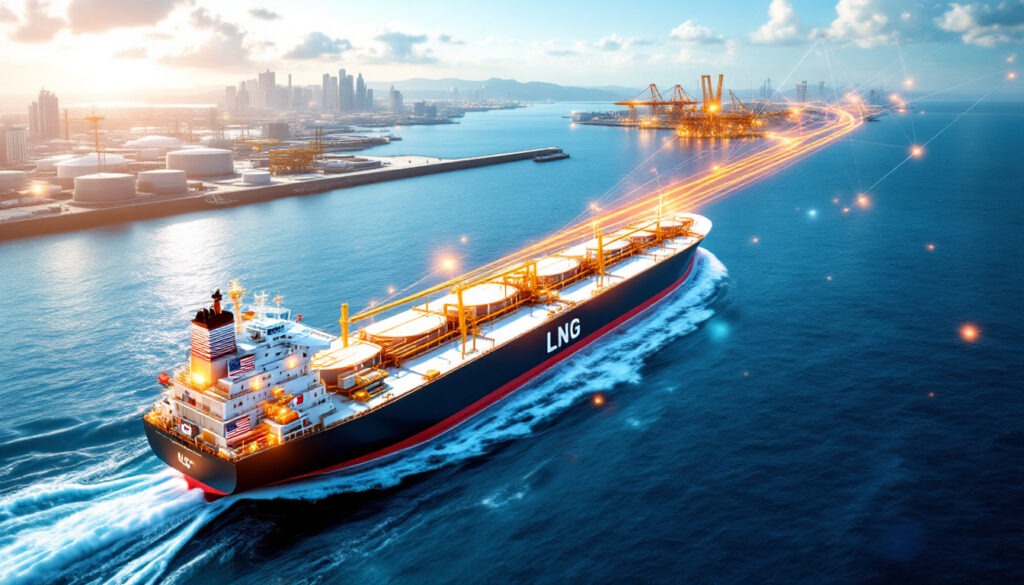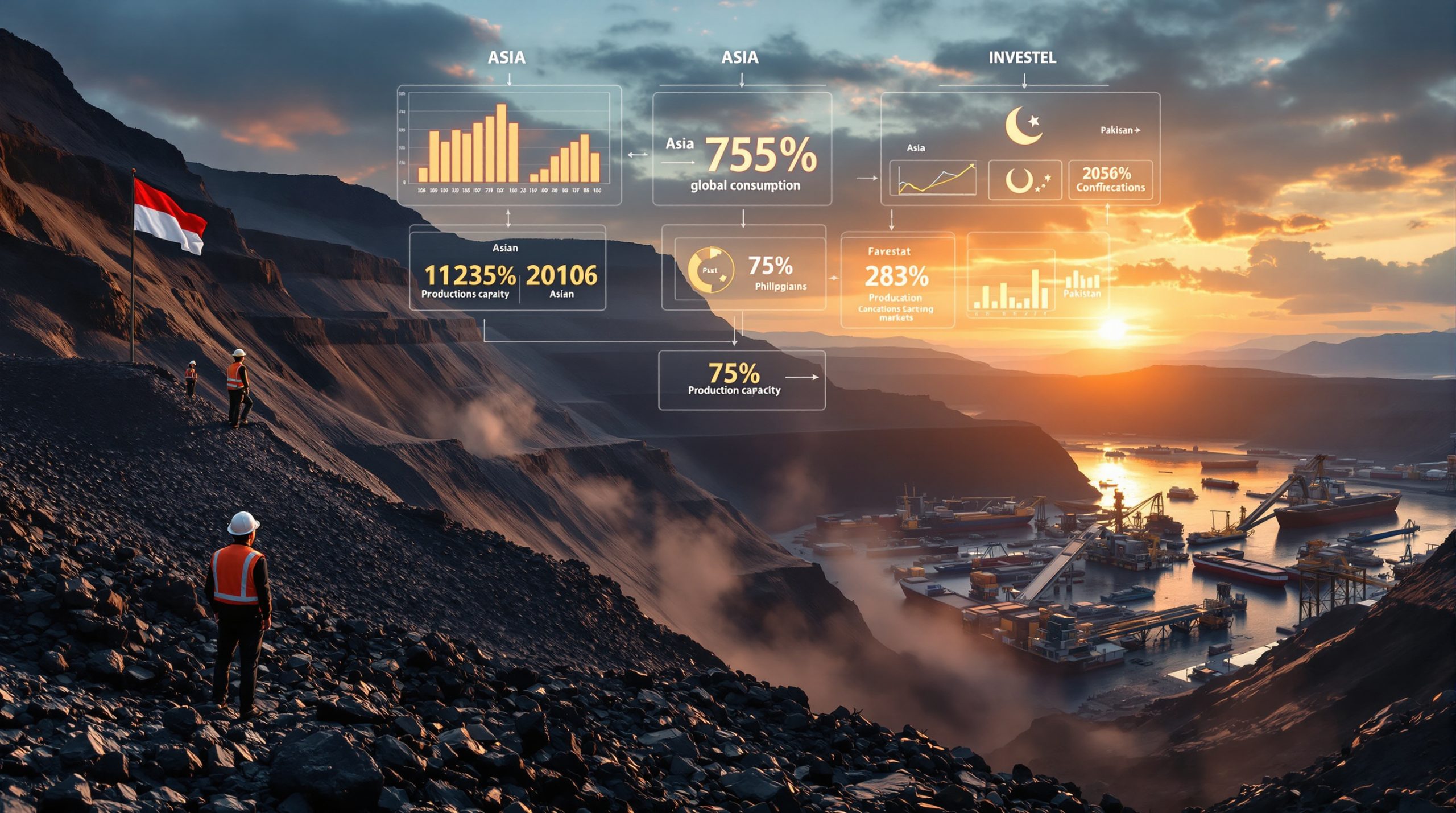Asian Nations Rush to Buy US LNG to Navigate Tariff Pressures
In recent years, a significant shift has occurred in international trade dynamics as Asian nations increasingly turn to US liquefied natural gas (LNG) imports. This strategic move comes amid heightened trade tensions following the introduction of "reciprocal" tariffs under former President Donald Trump's administration. Countries across Asia—particularly South Korea, Indonesia, Japan, and Taiwan—are actively pursuing long-term LNG deals with American suppliers, aiming to mitigate tariff pressures while addressing their growing energy needs.
According to Bloomberg's energy reporter Stephen Stapczynski, "Asian governments from South Korea to Indonesia are rushing to sign up for liquefied natural gas purchases from the US" as part of a calculated diplomatic and economic strategy. This surge in interest represents more than simple energy procurement—it's emerging as a sophisticated approach to balancing trade relationships with the United States while securing vital energy resources.
The timing couldn't be more critical, as Asian economies face mounting pressure to reduce their substantial trade surpluses with the US. By increasing high-value imports like LNG, these nations aim to demonstrate commitment to more balanced trade while strengthening diplomatic ties through energy cooperation.
Understanding the US "Reciprocal" Tariffs Policy
What are reciprocal tariffs?
Reciprocal tariffs represent a cornerstone of American trade policy introduced during the Trump administration and maintained through 2025. This approach operates on a simple principle: if a foreign nation imposes tariffs on US goods, the United States responds with matching or proportional duties on that country's exports.
The policy aims to achieve two primary objectives: reducing America's persistent trade deficits with major trading partners and creating leverage to negotiate more favorable trade terms. Unlike previous approaches that emphasized multilateral agreements, reciprocal tariffs focus on bilateral relationships with specific trading partners, particularly those with significant trade surpluses against the US.
US trade representatives have consistently emphasized that these measures are designed to enforce "fair" trade practices, not restrict global commerce. The underlying philosophy posits that by creating temporary economic pressure, trading partners will be motivated to open their markets more equitably to American goods and services.
Impact of reciprocal tariffs on Asian economies
For export-dependent Asian economies, the reciprocal tariffs have presented serious challenges. South Korean automotive manufacturers, Japanese electronics firms, and Taiwanese semiconductor companies have all felt the impact of increased costs when exporting to their largest market.
The economic consequences extend beyond direct tariff costs. Supply chain disruptions, market uncertainty, and reduced competitiveness against domestic US alternatives have compounded the pressure on Asian exporters. For instance, South Korean steel exports to the US declined by approximately 15% following the implementation of Section 232 tariffs.
These economic realities have forced Asian policymakers to develop creative mitigation strategies, with increased energy imports from the US emerging as a particularly attractive option. By redirecting billions of dollars toward American LNG, Asian nations can demonstrate concrete action toward reducing trade imbalances while satisfying their growing energy requirements.
Why are Asian Nations Targeting US Liquefied Natural Gas (LNG)?
Demand growth in Asian energy markets
Asia's appetite for natural gas continues to expand dramatically, with regional LNG demand projected to grow 3-5% annually through 2030. This trend is driven by multiple factors: environmental policies favoring cleaner-burning fuels, economic growth increasing overall energy consumption, and strategic efforts to diversify energy sources away from coal.
Japan, already the world's largest LNG importer, continues to rely heavily on gas following its shift away from nuclear power post-Fukushima. South Korea's energy transition plan emphasizes gas as a bridge fuel as it phases out coal and nuclear facilities. Meanwhile, emerging economies like Indonesia are increasingly turning to LNG for power generation and industrial applications.
The Asia-Pacific region now accounts for over 70% of global LNG imports, creating tremendous opportunities for major suppliers. With the United States emerging as the world's preeminent LNG exporter, Asian countries see a natural alignment between their energy security needs and trade balancing objectives.
Strategic benefits of LNG trade to Asia-US relations
Beyond the immediate economic considerations, LNG trade offers significant geopolitical advantages. As Stephen Stapczynski notes, these purchases serve as a "strategic tool" that combines energy security with trade diplomacy.
For Asian nations, diversifying energy suppliers reduces dependence on traditional LNG sources like Qatar, Australia, and Russia. This diversification provides both supply security and negotiating leverage with existing suppliers.
From a diplomatic perspective, substantial energy contracts create a foundation for broader cooperation. These multi-decade agreements, often worth tens of billions of dollars, establish lasting commercial ties that can help stabilize relations even during periods of political tension. Furthermore, understanding Trump's energy policies and developing effective geopolitical investor strategies becomes increasingly important in this context.
Current Status of Asia-US LNG Trade Agreements
Recent LNG agreements: Major Asian nations commitments (2025)
The scale of Asia's commitment to US LNG is remarkable, with major economies securing substantial long-term contracts:
| Country | Contracted Volumes (million metric tons/year) | Approximate Contract Value (USD) |
|---|---|---|
| South Korea | 10.5 | $25 billion |
| Indonesia | 7.2 | $18 billion |
| Japan | 15.0 | $35 billion |
| Taiwan | 5.8 | $12 billion |
These contracts typically span 15-20 years, representing significant long-term commitments to US energy sources. Japan's 20-year agreement with Cheniere Energy stands out as particularly substantial, underscoring the country's strategy to maintain energy security while addressing trade balance concerns.
Contract structures vary, with some based on Henry Hub pricing (linked to US natural gas benchmark prices) while others incorporate hybrid models that combine domestic US prices with international oil benchmarks. This diversity reflects the evolving nature of global LNG pricing mechanisms as the market matures.
Spotlight: Cheniere Sabine Pass LNG Terminal
The centerpiece of America's LNG export capability is Cheniere Energy's Sabine Pass terminal in Louisiana. With six operational liquefaction trains and a total capacity of approximately 30 million metric tons per annum (MTPA), Sabine Pass has transformed the United States into the world's largest LNG exporter.
The terminal represents a remarkable engineering achievement, capable of cooling natural gas to -260°F (-162°C), at which point it condenses into liquid form, reducing its volume by approximately 600 times. This process allows for efficient transportation via specialized tanker ships to distant Asian markets.
Sabine Pass's strategic location on the Gulf Coast provides direct access to abundant US natural gas supplies while offering efficient shipping routes to Asia via the Panama Canal. The facility's reliability and expanding capacity have made it a cornerstone of US energy exports and a critical asset in America's trade diplomacy.
Benefits & Risks for Asian Economies in Increasing US LNG imports
Economic advantages of increased US LNG imports
For Asian nations, the economic rationale for purchasing American LNG extends beyond tariff relief. As Stapczynski observes, these deals create tangible trade balance improvements that can be highlighted in negotiations with US trade representatives.
Supply security represents another significant advantage. By diversifying LNG sources away from traditional suppliers like Qatar, Australia, and Russia, Asian economies reduce vulnerability to regional supply disruptions or producer cartel behavior. The sheer scale of US production capacity provides assurance that contracted volumes will remain available even during periods of market tightness.
From a pricing perspective, US LNG offers an alternative to oil-indexed contracts that have historically dominated the Asian market. Henry Hub-linked pricing can provide greater transparency and potentially lower costs during periods when oil prices rise faster than natural gas values. For investors seeking to understand these complexities, global market insights and market dynamics explained resources can provide valuable context.
Risks and drawbacks to consider
Despite the advantages, Asian buyers face meaningful risks in their pivot toward US LNG. Price volatility remains a significant concern, with LNG spot prices demonstrating extreme fluctuations—sometimes exceeding 300% over relatively short periods. While long-term contracts provide some insulation from market swings, they may lock buyers into potentially unfavorable pricing if market conditions shift dramatically.
Contract structures present another risk factor. Most US LNG deals include "take-or-pay" provisions requiring payment regardless of whether the buyer actually needs the full contracted volume. During demand downturns, these obligations can create significant financial burdens for Asian utilities and gas distributors.
Transportation logistics introduce additional complexities. The extended shipping distance from the US Gulf Coast to Asian terminals—approximately 9,000 nautical miles through the Panama Canal—creates both higher costs and increased exposure to shipping disruptions compared to closer suppliers like Australia (approximately 3,500 nautical miles to Japan).
Comparing US LNG Imports with Alternative LNG Suppliers
US LNG vs. Qatar/Australia LNG
When evaluating LNG supply options, Asian buyers must weigh various factors beyond simple pricing:
| Factor | US LNG | Qatar LNG | Australian LNG |
|---|---|---|---|
| Production Cost | $7-9/MMBtu | $4-6/MMBtu | $6-8/MMBtu |
| Contract Flexibility | Moderate | Low | Moderate |
| Supply Security | High | Moderate | High |
| Shipping Distance to Tokyo | ~9,000 nm | ~6,800 nm | ~3,500 nm |
| Political Relationship | Complex/Strategic | Transactional | Allied |
While Qatar can offer more competitive production costs due to its enormous North Field and integrated operations, US suppliers typically provide greater contract flexibility and pricing transparency. Australian projects offer geographic advantages for Asian buyers but face capacity constraints and occasional production challenges related to labor disputes.
Expert analysis: Why choose US LNG over traditional suppliers?
Industry experts point to several factors driving Asian preference for US LNG beyond simple economic calculations. As one energy analyst observes, "US LNG offers political stability, not cost efficiency."
The concept of "supply diversification" dominates these decisions. No prudent energy security strategy relies too heavily on any single source region, making US volumes attractive even when they don't offer the lowest delivered cost. This approach aligns with the broader "energy security" paradigm that has gained prominence following recent geopolitical disruptions.
The regulatory and political environment surrounding US LNG exports also offers advantages. American projects operate with minimal government interference in pricing or destination restrictions, unlike some competing suppliers that maintain various forms of market control. This creates greater long-term predictability for buyers making multi-decade commitments.
How Will US Gas Tariffs Influence Future Trade Relations?
Possible scenarios & outcomes
Looking ahead, increased LNG trade could catalyze broader improvements in Asia-US economic relations. Under optimistic scenarios, substantial gas purchases might trigger proportional tariff reductions, with hypothetical formulas suggesting 5-10% tariff relief for every 1 MTPA of contracted LNG imports.
This dynamic could extend beyond the energy sector. As trade tensions ease through balanced energy commerce, negotiations might progress more smoothly in other sensitive areas like automotive exports, electronics, and agricultural products. Some analysts envision "linkage clauses" in future trade agreements specifically connecting energy purchases to broader tariff structures.
However, less favorable outcomes remain possible. If Asian LNG commitments fail to substantially reduce overall trade imbalances—particularly with manufacturing powerhouses like South Korea—pressure for additional tariffs could persist. The effectiveness of the LNG strategy ultimately depends on its scale relative to total bilateral trade volumes.
Expert predictions
Energy market specialists anticipate several developments in the coming years, according to insights from Bloomberg reporting. LNG's role in trade diplomacy is expected to expand, with contracts increasingly incorporating explicit trade-balance provisions or preferential terms tied to broader economic cooperation.
As Stapczynski notes, these deals could "pave the way for broader trade negotiations" by establishing goodwill and demonstrating concrete action on reducing imbalances. This model might ultimately extend to other US commodity exports, including agricultural products and petrochemicals.
Long-term, experts predict the emergence of more sophisticated arrangements combining energy trade, technology transfer, and investment commitments. Rather than viewing LNG purchases as simple commodity transactions, both Asian buyers and US suppliers increasingly approach them as strategic partnerships with wide-ranging economic implications.
FAQ: Quick Guide to US Gas Tariffs and Asia-US LNG Agreements
What are the reciprocal tariffs imposed by the US government?
Reciprocal tariffs are import duties imposed by the United States on foreign goods that match or respond to tariffs placed on American exports by other countries. These measures aim to create more balanced trade relationships by incentivizing trading partners to reduce their own barriers to US products.
Why is liquefied natural gas (LNG) important in Asia-US trade strategies?
LNG serves multiple strategic purposes in Asia-US relations. For Asian nations, it provides essential energy for economic growth while demonstrating commitment to reducing trade surpluses. For the US, LNG exports generate revenue, create jobs, and strengthen diplomatic ties with key Asian partners.
Which Asian countries are currently the top buyers of US LNG in 2025?
Japan leads US LNG purchases (approximately 25% of exports), followed by South Korea (20%), China (18%), and Taiwan (8%). Indonesia has recently emerged as a significant growth market, particularly as it transitions from an LNG exporter to a net importer due to rising domestic demand.
What role does LNG play in balancing Asia-US trade deficits?
LNG imports represent high-value purchases that directly reduce trade imbalances. For example, a $1 billion LNG purchase effectively offsets approximately $1.3 billion in potential tariff liabilities based on current trade adjustment calculations, making it an efficient tool for deficit reduction.
The Future of Asia-US LNG Trade Relationships
The growing LNG trade between Asian nations and US gas suppliers represents more than simple commercial transactions—it's reshaping the economic architecture of trans-Pacific relations. As Asian nations continue pursuing American gas to mitigate tariff pressures, both regions stand to benefit from enhanced energy security and more balanced trade.
The strategic implications extend well beyond the energy sector. These long-term agreements create durable economic interdependence that can help stabilize diplomatic relations even during periods of political tension. By establishing commercial frameworks spanning decades, LNG contracts provide a foundation for broader cooperation on trade, investment, and technology.
For global LNG markets, the Asia-US axis is fundamentally altering traditional trade flows. Middle Eastern producers increasingly target European customers as Asian buyers pivot toward American supplies. This reconfiguration of global energy commerce reflects both market forces and geopolitical calculations.
Ultimately, the success of this strategy hinges on whether LNG purchases can meaningfully address the structural trade imbalances that triggered reciprocal tariffs. If Asian nations demonstrate sustained commitment to American energy imports as part of broader trade balancing efforts, they may well achieve the tariff relief they seek while securing vital energy resources for their growing economies. These developments may also signal the beginning of a new commodity super cycle that could reshape global energy markets for decades to come.
Relevant Citations
Stephen Stapczynski, Bloomberg Energy Reporter, "Asian Nations Rush for US LNG Amid Tariff Concerns," Bloomberg, April 9, 2025.
U.S. Energy Information Administration, "LNG Export Capacity Forecast: 2025-2030," Annual Energy Outlook 2025.
International Energy Agency, "Global Gas Security Review," IEA Market Report Series, 2025.
Want to Discover the Next Major Mineral Opportunity?
Get real-time alerts on significant ASX mineral discoveries with Discovery Alert's proprietary Discovery IQ model, transforming complex data into actionable investment insights. Visit our discoveries page to understand why historic discoveries can generate substantial returns and begin your 30-day free trial today to position yourself ahead of the market.




